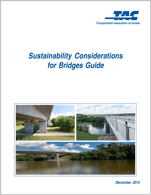The Sustainability Considerations for Bridges Guide helps transportation agencies and bridge professionals improve the sustainable (i.e., social, economic and environmental) benefits of their projects and communicate those improvements to stakeholders in a consistent and objective manner. It provides broad direction on sustainability considerations specific to bridge planning, design, construction and management.
The Guide begins by providing sustainability concepts (what is sustainability; setting priorities and making decisions) and describing 12 sustainability objectives (e.g. reducing energy use and emissions; improving safety, access and mobility). It then offers 22 practices sheets that describe a sustainability topic to be considered in a project. The following are a few of the practice topics included in the Guide:
- Bridge Aesthetics
- Bridge Lifecycle Cost Analysis
- Improve Material Reuse and Recycling
- Maintain or Improve Aquatic Ecosystems
- Reduce Construction Traffic Delay
Background: The road and highway bridge engineering community has long been considering many aspects of sustainability, such as safety, durability, and aesthetics. However, these efforts rarely are coordinated with the goal of improving sustainability, and are sometimes done without a clear understanding of the positive and negative effects to sustainability. Considering the growing awareness of sustainability, most authorities recognize that sustainability will need to become an important consideration when making decisions, setting policies, and meeting performance measures sought by stakeholders.


